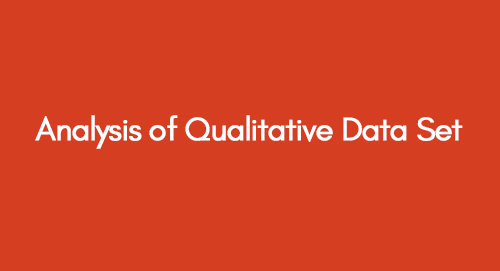
Different Approaches to Academic Research
July 9, 2022
Positive and Negative Effects of CBD Oil
July 9, 2022When we analyze qualitative data, it's like diving into stories and descriptions instead of numbers. It helps us understand people's experiences and thoughts by looking closely at what they share.
As per the study by Lavie, Arena, and Blair, (2016), increasing weight is the rising issue of the 21st Century and various aspects have been observed as positively contributing to the increment of the weight among the new generation. Another study has contributed as, increasing weight is not just the issue of the new generation but some elder people have crossed the age of 50 and have spent approximately half of their lives, are also facing similar issues regarding their weight (Bowman, et al. 2016).
Discover what Factors Contribute to Weight Gain in Both Older and Younger Generations
Therefore, in such a case, it becomes necessary to analyze that what are the elements which are common in both the elders and the young generation. It was observed that most youngsters have been consuming junk food that contains a large amount of fat and it could be the main reason behind their increasing weight (Altaf, et al. 2018). On the other hand, another trend was analyzed that the consumption of junk food among the elders is quite low, which raises the question that what the other factors are significant in this manner.
Furthermore, technological advancement has taken place which simplifies the job of the daily routine and it is the main reason behind the physical inactivity of most people. Moreover, it was studied that the lifestyle that a person has been availing is dependent on their income, which makes it clear that if a person is on a higher level of income, there are chances that he would be using more technological aspects in his daily life. This will directly contribute to his physical inactivity and it is evident by the study by Myers, et al. (2017), that if a person is physically inactive, there are chances that the weight of the person would increase significantly irrespective of his age and other factors. However, to make it clear that the aspects which contribute to the increasing weight are significant, this study has been conducted in which various independent variables have been analyzed to observe their impact on the single dependent variable which is the weight of the people.
Jakoi, et al. (2017), have mentioned in their study that there is a significant relationship between smoking status and the increasing weight of the body. However, various examples have been observed in which people who smoke were observed as losing weight. Therefore, in such a case, it was necessary to include the smoking status of the people in this study so that it would be clear if the smoking habit of people increases their weight or not. Factors that have been taken as the independent variable in this study include age, income level, height and weight of the body, gender, and smoking status. To keep the findings of the study unbiased, the data has been taken from a large number of sampthathich appropriathatrepresents the represent. Based upon the selected sample and methodology tests were applied to obtain the findings which helped in presenting the comprehensive conclusion.
To conduct any study, the most important element is to select the right method, as it has been studied that most studies fail due to the weak methodology.
Methods and Materials
There is a various aspect which is necessary to analyze while selecting the methodology for any study such as the selection of the sample, selecting the right tests, and the factors which should affect the dependent variable of the study. While selecting the sample size, it is necessary to analyze how large the population of the study is. Therefore, analyzing the population of the study, a sample size should be selected, it was observed study by Etikan, and Bala, (2017), that if the population is too large, it is necessary to keep the sample size also large so that the findings of the study would be unbiased. Furthermore, once the sample size of the study has been selected, the research instrument should be decided what would be the method for collecting the data from the sample (Taherdoost, 2016). Therefore, in this study, the data has been collected with the help of a survey questionnaire, in which the respondents of the study were provided with closed-ended questions and they had to select the given options regarding the different factors such as their gender and smoking status. However, for weight, height, and age, they were allowed to enter their respective answers in the given unit such as pound, inches, and years respectively. Moreover, when the respondents were asked to provide details regarding their income, they were provided with different slabs which define the income level and they had select any of the brackets in which their income lies.
Based upon the selected data, and the aim of the study, in which the researcher intended to find the impact of the multiple independent variables over a single dependent variable, test of the study was defined. Therefore, analyzing the related elements, multiple regression was applied over the sample of the study. Moreover, it is necessary to mention that the sample was taken from a large number of respondents that is 1350 people. Furthermore, while collecting the data for the study, there were some limitations tthatwasecided as the respondents should be above the age of 20, therefore, the respondents are between the ages of 20 to 89 years. In addition, their income brackets were defined into various levels between less than USD 1,000 to more than USD 150,000. The reason to break the income level into various brackets was to categorize the living standards based on their income levels as it has been studied that the income should be divided into levels to simplify the prediction of the tests’ results (Padley, and Marshall, 2018).
In addition, the most important aspect of the methodology of the study is, what approach has been used in the study. Two types of approaches can be used in any study, such as inductive and deductive approaches, and the decision for the approach of the study is usually made upon the fact that the study is investigating the results of the previously developed theories or developing its own (Jebb, Parrigon, and Woo, 2017). In this study, the researcher intended to develop its theory including the impact of the income level, age, height, gender, and smoking status of the people over their weight. Therefore, in this study, the researcher observed the patterns from the related literature that what are the factors which contribute to the increasing weight of the body and based upon it, tentative hypotheses were made. Furthermore, once the data was collected and the tests were applied, results were provided to the researcher which helped in making the conclusion which is considered the theory that has been developed by the study with the help of primary data collected by the researcher. In addition, to maintain the level of ethics in the study, every piece of information which is taken from the other studies has been credited to the real author of the study (Pietilä, et al. 2020). Furthermore, while taking the information from the secondary resources, the authenticity of the source has been considered so that the findings of the study should not be biased.
Results
This section of the assignment includes the results that have been obtained by executing relevant tests on SPSS on the given data set to reach suitable findings and conclusions. This section is divided into different parts to explain the findings properly.
Testing for Assumptions
Here are various assumptions made for the dataset below.
1. Normality
The data set provided is assumed to follow normal distribution. For the purpose of assessing the normality of each variable that has been taken into consideration, Kolmogorov-Smirnov test and Shapiro-Wilk test have been applied. The null hypothesis for this test is that the data is normally distributed, in case if the sig value are less than 0.05 or alpha value it indicates that the data is not normally distributed. The following table shows the normality for each variable taken into consideration:
Variables | Kolmogorov-Smirnov | Shapiro-Wilk |
Age | 0.000 | 0.000 |
Total Family Income | 0.000 | 0.000 |
Height | 0.000 | 0.000 |
Weight | 0.000 | 0.000 |
Smoking Status (Dummy Variable) | 0.000 | 0.000 |
Gender (Dummy Variable) | 0.000 | 0.000 |
Table 1: Normality Test
Source: Author (2020)
In the above table, it becomes evident that for all the variables the values for the Kolmogorov-Smirnov test and Shapiro-Wilk test appear to be 0.000 which is less than the benchmark set which indicates that the null hypothesis is deemed to be rejected. Hence, the dataset is not normally distributed.
2. Multicollinearity
Another major assumption for the data set is that there is no existence of multicollinearity in the existing dataset. In the case of the existence of multicollinearity, the statistical significance of the data is diluted hence, it is assumed that the data does not have the problem of multicollinearity. The following table shows the value of the Variance Inflation Factor (VIF) for each variable which needs to be less than 10 to prove that there is no multicollinearity in the data:
Variables | VIEW |
Age | 1.027 |
Total Family Income | 1.117 |
Height | 1.967 |
Smoking Status (Dummy Variable) | 1.111 |
Gender (Dummy Variable) | 1.952 |
Table 2: Multicollinearity Test
Source: Author (2020)
It is evident from the above table that there is no existence of the problem of multicollinearity in the variables since all the VIF values are less than 10.
3. Linear Relationship
Before testing different attributes for the weight of the sample size, it has been assumed that all the independent variables have a linear relationship with the dependent variable which is weight in pounds. To test this, each of the predicting variables is plotted against the weight to visually analyze the linearity, following are the graphs:

The above table indicates that there is a linear relationship between the weight of an individual and their height. The relation is seen to be positive as the line is upwards which means an increase in height brings about an increase in weight as well.

The above table indicates that there is no linear relationship between total family income and weight. It can be seen in the above graph that there are many fluctuations in the data which means that there is no linear pattern.

The above table indicates that there is no linear relationship between the age of an individual and their weight. It can be seen in the above graph that there are many fluctuations in the data which means that there is no linear pattern.
4. Multiple Regression
After testing the data for assumptions, multiple regression has been applied to the data set to find out the influence of predictors (age, gender, smoking status, height, and family income) on the criterion variable (weight in pounds). As mentioned in the methods and materials section, this data has been analyzed via SPSS. Considering that there were several independent variables in the model, the researcher applied multiple regression to test the relationship and impact. The following table indicates the results that have been obtained from SPSS:
Regression Analysis | ||||||
Intercept | Age | Gender | Smoking Status | Height | Family Income | |
Coefficient Value | -127.123 | -0.38 | -8.590 | 11.195 | 4.663 | -0.504 |
Standard Error | 25.755 | 0.064 | 2.935 | 2.575 | 0.361 | 0.199 |
T-stat | -4.936 | -0.597 | -2.927 | 4.347 | 12.902 | -2.541 |
P-value | 0.000 | 0.551 | 0.003 | 0.000 | 0.000 | 0.011 |
F-statistic | 90.729 | |||||
Sig. Value | 0.000 | |||||
R-squared | 0.252 | |||||
Adjusted R-squared | 0.249 | |||||
Table 3: Ordinary Least Squares
Source: Author (2020)
The above table shows all the relevant information that is required to analyze the significance and extent of the association/relationship of different attributes with the weight of individuals. The top portion of the table indicates the coefficient values and their respective sig values which shows whether or not there is statistical relevance in their relationship. Coefficient values for each of the predicting variables indicate the difference that is apparent in the dependent value due to one unit change in them.
The first predicting variable is Age which is tested against the weight in pounds of the respondents. The p-value assigned to this variable is 0.551 which lies outside the benchmark of 0.05 or below, thus, the individualistic impact of age on the weight of individuals is found to be statistically irrelevant. Considering that the relationship is insignificant, there is no point in explaining the coefficient value since it depicts the extent of change in the weight caused by one unit change in age.
Secondly, the impact of gender is tested on the weight of an individual, which means that whether or not belonging to a specific gender influences the weight of a person. . The p-value assigned to this variable is 0.003 which lies within the benchmark of 0.05 or below, thus, the individualistic impact of gender on the weight of individuals is found to be statistically relevant and significant. The coefficient value for this variable is -8.590 which means that gender can significantly predict the weight of an individual.
The next variable is smoking status which means whether or not an individual smokes. The impact of this variable is tested on the weight of an individual, this means whether or not smoking influences the weight of a person. The p-value assigned to this variable is 0.000 which lies within the benchmark of 0.05 or below, thus, the individualistic impact of an individual being a smoker on the weight of individuals is found to be statistically relevant and significant. The coefficient value for this variable is 11.195 which means that smoking status can significantly predict the weight of an individual.
The next individual attribute that has been tested is height in inches. The impact of this variable is tested on the weight of an individual, this means that whether a person is taller or shorter impacts their weight or not. The p-value assigned to this variable is 0.000 which lies within the benchmark of 0.05 or below, thus, the individualistic impact of the height of an individual on the weight of individuals is found to be statistically relevant and significant. The coefficient value for this variable is 4.663, this indicates that if an inch of height of an individual is increased, it will bring about a 4.663 units change in the weight of a person.
The last variable is total family income which is not a personal attribute but a social factor. The impact of this variable is tested on the weight of an individual, this means whether a person belonging to a certain income group impacts their weight or not. The p-value assigned to this variable is 0.011 which lies within the benchmark of 0.05 or below, thus, the individualistic impact of total family income on the weight of individuals is found to be statistically relevant and significant. The coefficient value for this variable is -0.504, this indicates that an increase in total family income can reduce the weight of an individual as there is a negative sign associated with the coefficient.
In the bottom section of the table, certain values collectively explain the entire model including all the predicting factors and crvariablesvariable taken into consideration. Sig. value determined the complete statistical relevance of the model. The p-value assigned to the model is 0.000 which lies within the benchmark of 0.05 or below, thus, the overall and collective impact of total family income, age, gender, height, and smoking on the weight of individuals is found to be statistically relevant and significant. R-square value is another important value to be interpreted to explain ordinary least squares regression in a detailed manner. R-square value otherwise known as the coefficient of determination shows the ability of the independent variable in terms of predicting the variance that occurs in the dependent variable. In the case of the model in consideration, total family income, age, gender, height, and smoking can explain 0.252 or 25.2% of the variation in the weight of respondents. Lastly, an adjusted R-square can be referred to as a modified version of the coefficient of determination which is being adjusted by the number of independent variables in the model. Thus, after adjustment, total family income, age, gender, height, and smoking can explain 0.249 or 24.9% of the variation in weight of individuals.
The above section has incorporated detailed analysis of the results that were obtained from SPSS. In this section, the primary results will be analyzed in light of the previous findings about the variables taken into consideration by referring to the available literature.
Discussion
There is an abundance of research that can be found on the impact of different personal and social attributes and their influence on their weight. The study conducted by Stevens (2000) was focused on findings on age associations with weight. In this study a direct relationship between age on weight was not evaluated, rather the author aimed to study how age influences weight. The results of the research showed that age has a significant relationship with obesity among men and women in the age bracket of 30-74 which was the sample size. However, from the primary findings, it can be evaluated that there is no significant individualistic impact of age on weight.
The research conducted by Lopez et al. (2018) has been conducted to analyze the influence of gender on obesity. The findings of the study have indicated that females are more prone to be obese as compared to women. However, it is important to take into consideration the fact that this study considered rats as their sample. This means that there can be differences in the results of this research. The findings of this research indicated that gender has an impact on the weight of the individual. The primary results of this research showed that there is a positive impact of income as well as height on the weight of individuals. It is a commonly accepted notion that if a person has a greater height they will also have more weight because of their bones. The study conducted by Buser et al. (2016) was aimed at assessing the impact of changes in income on the height and weight of young children. The sample for this research comprised young children of families in Ecuador. The results of this research indicated that there is no significant influence of changes in income on the heights and weights of young children. However, the findings of this research have suggested that there is a significant influence of income on weight. It is important to take into consideration the fact that when the linearity of the relationship of income was tested against weight, it was found linear relationship does not exist among them.
The results have indicated that there the model is relevant in statistical terms as the overall sig value has appeared to be less than the benchmark value of alpha. However, while judging the attributes individually, it was found that age does not tend to impact the weight of an individual.
Conclusion
With the help of the results of the study, it has become evident that the overall model was significant and there is a significant impact of the independent variables over the dependent variable. However, when the impact of the variables was checked individually, it was found that there is no relation between the age and the weight of the people. While conducting the study, two assumptions were taken regarding the data such as the data is normally distributed and there is no multicollinearity among the variables. However, tests of the study have shown that the data is not normally distributed however the assumption regarding the multicollinearity was correct. Furthermore, the results of the tests have shown that there is a linear relationship between the height and weight of the body, which means that if the height of person increases, there is a greater probability that the weight of the person would also increase. In addition, the relation between weight and income was also tested along with the relation between age and weight, and it was observed that there is a non-linear relation between the variables respectively.
References
Altaf, B., Khan, M.B., Aftaab, R.K., Jawed, S., Salam, R.M.T. and Amir, F., 2018. NUTRITIONAL DEFICIENCY ANEMIA; ROLE OF JUNK FOOD IN NUTRITIONAL DEFICIENCY ANEMIA AMONG YOUNGSTERS. Professional Medical Journal, 25(7).
Bowman, K., Delgado, J., Henley, W.E., Masoli, J.A., Kos, K., Brayne, C., Thokala, P., Lafortune, L., Kuchel, G.A., Ble, A. and Melzer, D., 2016. Obesity in older people with and without conditions associated with weight loss: follow-up of 955,000 primary care patients. Journals of Gerontology Series A: Biomedical Sciences and Medical Sciences, 72(2), pp.203-209.
Buser, T., Oosterbeek, H., Plug, E., Ponce, J. and Rosero, J., 2016. The impact of positive and negative income changes on the height and weight of young children. The World Bank Economic Review, 31(3), pp.786-808.
Etikan, I. and Bala, K., 2017. Sampling and sampling methods. Biometrics & Biostatistics International Journal, 5(6), p.00149.
Jakoi, A.M., Pannu, G., D'oro, A., Buser, Z., Pham, M.H., Patel, N.N., Hsieh, P.C., Liu, J.C., Acosta, F.L., Hah, R. and Wang, J.C., 2017. The clinical correlations between diabetes, cigarette smoking and obesity on intervertebral degenerative disc disease of the lumbar spine. Asian spine journal, 11(3), p.337.
Jebb, A.T., Parrigon, S. and Woo, S.E., 2017. Exploratory data analysis as a foundation of inductive research. Human Resource Management Review, 27(2), pp.265-276.
Lavie, C.J., Arena, R. and Blair, S.N., 2016. A call to increase physical activity across the globe in the 21st century.
López, N., Sánchez, J., Palou, A. and Serra, F., 2018. Gender-associated impact of early leucine supplementation on adult predisposition to obesity in rats. Nutrients, 10(1), p.76.
Myers, A., Gibbons, C., Finlayson, G. and Blundell, J., 2017. Associations among sedentary and active behaviours, body fat and appetite dysregulation: investigating the myth of physical inactivity and obesity. Br J Sports Med, 51(21), pp.1540-1544.
Padley, M. and Marshall, L., 2018. Defining and measuring housing affordability using the Minimum Income Standard Housing Studies. Housing Studies, pp.1-23.
Pietilä, A.M., Nurmi, S.M., Halkoaho, A. and Kyngäs, H., 2020. Qualitative Research: Ethical Considerations. In The Application of Content Analysis in Nursing Science Research (pp. 49-69). Springer, Cham.
Stevens, J., 2000. Impact of age on associations between weight and mortality. Nutrition reviews, 58(5), pp.129-137.
Taherdoost, H., 2016. Validity and reliability of the research instrument; how to test the validation of a questionnaire/survey in a research.
Get 3+ Free Dissertation Topics within 24 hours?



























